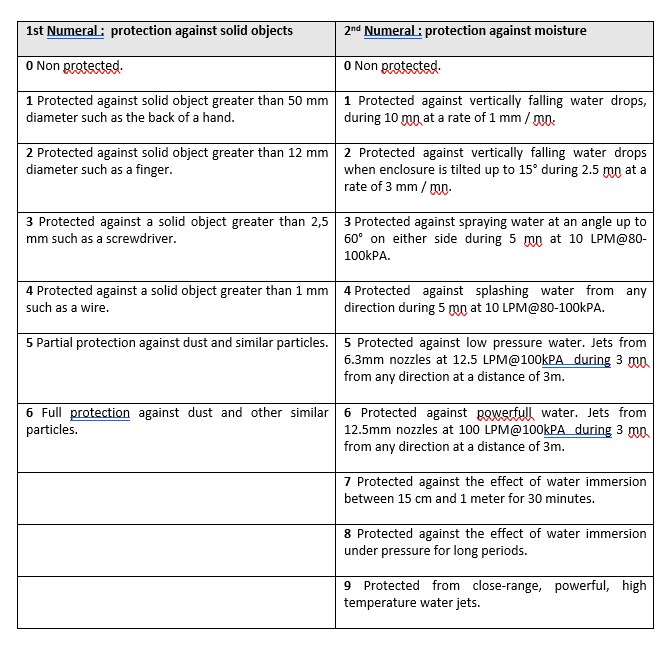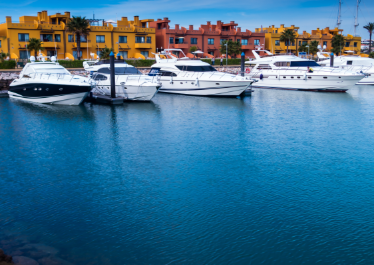IP65, IP66, IP67: which Ingress Protection rating should be used in the design of pleasure boats?

To guarantee the safety of boaters, there are standards that designers must scrupulously follow. This is the case for IP protection ratings, which guarantee the resistance of the equipment to its environment. Indeed, in the design of pleasure boats, the resistance and watertightness of the products on board is an essential issue, which becomes crucial when it comes to electronic devices. Find out in this article which IP ratings are to be preferred in the selection of your pleasure boats equipments!
IP65: What is an IP rating?
IP ratings were created by the International Electrotechnical Commission (IEC) in 1989. They describe the standards of protection against intrusion and thus make it possible to know if the devices are able to resist their environment.
IP rating is a classification usually with two digits and optional letter system applied to the enclosure of a mechanical or electrical item, which gives the user a clear indication of the item's resistance to various types of intrusion.
Although there are slight differences in IP ratings, depending on where the product is purchased, they are standardized in most regions. In Europe, they conform to IEC 60509:1989, and internationally they conform to EN 60529 certification.
The IP rating concerns electrical equipment in general and is particularly important in the selection of boats equipment’s. Based on the location of equipment on board such as control room, bridge, engine room, deck the minimum IP rating required may vary.
Read also: Guide to the standards to be met in the design of recreational craft
IP65, IP66, IP67... Why an IP rating system?
The purpose of a universal IP rating system is to assure engineers and users that certain electrical or mechanical products are safe to use in specific environments and applications.
Unlike generic terms such as "waterproof" which do not precisely define the characteristics of waterproofing or dust resistance, the IP rating has been put in place to precisely define the degrees of protection.
What does an IP rating measure?
Each of the numbers in an IP rating reveals detailed information about three key parameters:
- Resistance to penetration, accidental or otherwise, by the user.
- Resistance to penetration by foreign objects (dust, dirt, etc.).
- Resistance to moisture penetration.
In general, therefore, the IP rating consists of two digits, sometimes followed by a letter indicating specific materials, risks or test scenarios. The most common way of indicating such an index is the format "IP43", "IP67".
The first digit is between 0 and 6 and indicates the degree of protection against the ingress of solid foreign objects (the user himself and other potentially dangerous items such as tool, cable or dust).
The second digit of the IP rating is between 0 and 9 and indicates the degree of exposure to both water jets and temporary or continuous immersion. A number replaced by X indicates that the enclosures is not rated for this standard.
IP rating table
The IP rating table indicates the meaning of each digit in a standard IP code. It provides a clear indication of the specific risks and scenarios against which the mechanical or electrical components enclosure of a product must be protected, to what extent and in what type of environment.

Recreational boat design: Importance of IP ratings for electrical equipment
As with all other types of equipment, IP ratings for electrical equipment follow the international standards for a better understanding. In the marine industry , including the design of battey charger, the choice of IP ratings is very sensitive. In marine applications, it becomes even more important to consider the types of potential exposure, protective resistance and sealing required for the proper operation of electronic components or systems. Moisture and even more salt spray can often lead to damage or reduce the life of equipment. This is why the choice of “marine grade” equipment is highly recommended.
Particular attention should therefore be paid to potential ingress from less obvious sources of moisture or particles, salt spray , fuel vapor, or marine engine dust for example.
Read also: Boat battery charger: everything you need to know
What protection ratings should be used in the selection of marine equipment ?
In marine equipment, except for tools, moisture takes precedence over dust resistance. Indeed, the more waterproof the products are, the more they limit installation constraints. As far as pleasure boating is concerned, the watertightness index must not be less than 4, i.e. the level of resistance to spraying. For example, typical IP ratings for equipment on open boats or RIB’s are IP67, IP66 and IP65. The table below gives details of what these ratings mean and how they are measured.

However, these high ratings are not always necessary. For battery chargers, for example, lower ratings are sometimes accepted. In fact, in the boating or marine field, the IP rating will depend on the environment in which the battery charger will be installed. For example, for a battery charger located in a technical room, an IP22 rating will suffice, whereas an IP44 rating will be required for a charging device installed in an engine room. Finally, in an area potentially subject to water splashes, an IP65 rating will be required as a minimum.
Since 1996, Dolphin Charger has been designing, manufacturing and distributing a complete range of robust and intelligent power conversion products and solutions. As a marine specialist, Dolphin Charger has designed the "Pro Lite" range. A range of waterproof, IP65, ISO 8846, BlueTooth, fanless and ultra-quiet battery chargers, specially adapted to the specificities of pleasure boats. From its design office based in France, Dolphin Charger develops quality products, recognised for their reliability and certified DNV-GL. Want to know more? Discover our "Pro Lite" battery chargers!



